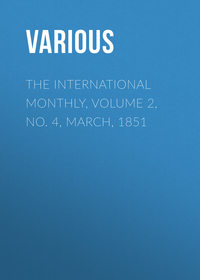 полная версия
полная версияDonahoe's Magazine, Volume 15, No. 4, April, 1886
"
The Ursuline Convent of Tenos
Twenty-three years ago there started from France four Ursuline nuns with the intention of founding a convent of their order in the island of Tenos, in the Greek Archipelago. The first idea had been to found this establishment in Syra, the chief commercial town of the Cyclades; but insuperable difficulties turned their hopes to Tenos, known to the ancient Greeks as the island of Serpents. Nothing could be more picturesque and lovely than the island, nothing less civilized. These four ladies, of high courage and energy, left the shores of the most civilized country in the world with the small sum of six hundred francs, upon which they resolved to start a school of Catholic education and charity in an island which had ceased to be universally Catholic from the time of Venetian rule. Having gone over the ground and realized (only dimly) their enormous difficulties, the complete sacrifice they were compelled to make of all bodily comforts, and the unendurable conditions of existence they bravely faced, I can only compare their courage with that which formed the annals of the earliest stages of Christianity. Becalmed upon a whimsical sea, they arrived at Tenos a little before eight in the evening. Tenos was the spot selected, or rather its village, Lutra, because the bishop had consented to the erection of a convent in his diocese. To readers accustomed to the resources of civilized travelling the hour of arrival is an inconsequent detail. Not so even to-day in Tenos. Judge, then, what it must have been twenty-three years ago! Four delicately nurtured women had to face a dark, rocky road, more of the nature of a sheer precipice than a road, late at night upon mules. I made the same journey at mid-day and felt more dead than alive after it. There is positively not a vestige of roadway up the whole steep mountain pass, nothing but large rocks and broken marbles, though the traveller in search of the picturesque is amply repaid the discomfort of the ride. But compared with the village of Lutra, which was the destination of the nuns, this wild and dangerous-looking path is a kind of preliminary paradise. No word-painting of the most realistic school could do justice to the horror of Lutra to-day – and what must it have been there before the refining influence of those nuns touched it? This dirty stone-built and tumble-down village the four nuns entered at eight o'clock, when darkness covered its ugliness, but greatly increased its dangers. The first entrance winds under an intricate line of narrow stone arches, the pavement uneven, the mingling of odors unimaginable. Through this unearthly awfulness they bravely struggled and reached their destination at last. A Father from the neighboring community had heard of their expected arrival, and was already superintending the rough and hurried details of their reception. I saw the house which stands just as it was when the Ursuline nuns first made it their residence. A mud cabin containing two rooms: kitchen and dining-room, bedroom and chapel. The roof is made of stones thrown loosely over wooden beams placed far apart, the two rooms separated by a whitewashed arch instead of a door. There are no windows; but spaces are cut in the walls which served to let in the light and air, and at night were covered by shutters. Hail, rain, or snow, it was necessary to keep these spaces open by day in order to see, and it is not surprising that one of the nuns was soon prostrated by a dangerous fever. The beds were mattresses stuffed with something remarkably like potatoes, and laid on the mud floor at night, upon which the nuns slept a short, ascetic sleep.
Here they remained for some time, going among the villagers and soliciting that the poor would send their children to be taught. This the poor did, and gradually the children began to fill the kitchen of the mud cabin. If it rained during class umbrellas had to be put up as a protection under a nominal roof, just as the nuns had to sleep under umbrellas in wet weather. Indeed, sometimes it rained so hard that they were obliged to take up their mattresses at night, and seek a more sheltered spot elsewhere. At last the number of their charity pupils increased; and the bishop, as poor as they were almost, offered them the only asylum in his power, his own paternal home, also a mud cabin; but instead of two miserable rooms it contained four. This was an immense improvement, and the nuns felt like exchanging a cottage for a palace. But here the protection of umbrellas was still necessary, as the roof was also made of loosely set stones and beams. In time other nuns joined them from France, until they formed a community of eleven, with eighty village school children and one boarder. It grew daily more and more necessary that something should be done to raise money to build a convent. Their couches had been slowly raised from a mud floor to tables, upon which they slept the sleep of Trappists; but a proper establishment was now indispensable to the work they had laid themselves out to do. With this object, two nuns set out on a supplicating mission round the Levant. They were less successful than they had perhaps anticipated, for they returned after their arduous task only enriched by eight thousand francs. With this sum they were enabled to build a small portion of the present establishment; but building in a Greek island is slow and costly work. Each stone has to be carried up the long mountain pass from the quarries; the way is difficult, the men unaccustomed to prompt work.
However, in due time the nuns were enabled to leave the bishop's homely roof, where their chapel was a tiny closet separated from the class and dining-room by a curtain, and the beds the tables used during the day with umbrellas for a roof.
Two nuns later made the tour of France in search of funds, and were rewarded for their unpleasant undertaking by the sum of twenty-five thousand francs, which added something more to the building already commenced, and smaller sums, together with pupils, came afterwards. Now they have between fifty and sixty pupils who are paid for, and almost as large a number of charity children and orphans who are supported at the expense of the convent. These children are all Greeks or Levantines; but as the language of the Order is French, they speak French fluently.
So much for a general idea of the immense difficulties in the way of foundation, and for an outline of the personal sacrifices and admirable courage which has carried it through. I will now try to give an outline of what has been done. To begin with the island of Tenos, although extremely picturesque, with its marble rocks, its clear, bare hills shadowed lightly by purple thyme and gray olives and torrent beds in dry weather forming zigzag lines of pink-blossomed oleanders, fig-trees, mulberries, tall, feathery-headed reeds and orange and lemon trees, is as devoid of all the necessary adjuncts of modern existence as it is possible to imagine any place. As you approach it, it lies upon the deep, blue Mediterranean, a stretch of dimpled brown hills, curve laid inextricably upon curve, its apparent barrenness softened in the beauty of shape, as the morning sea mist, which has rested upon its base like a fine white veil, gradually lifts itself into the clouds. From an æsthetic point of view, the picture is admirable; but the least fastidious of travellers must at once recognize the almost impossibility of raising upon it anything like a comfortable European home. Yet, nevertheless, this gigantic feat is what the nuns, by a peculiar genius, patient perseverance, and severe economy, have accomplished. The two-roomed mud cabin of twenty-three years ago is now a tradition, and they have made themselves a lovely centre above the dirty village of Lutra. They have cultivated the stony, impoverished soil till their gardens are thickly foliaged by lemons, oranges, figs, pomegranates, cactuses, oleanders, oaks, olives, apples, pears, and apricots. These fruits are consumed in the convent partly, and the surplus is sold in Syra for a mere song, which, if they could export to England would yield them a profitable interest. Their gardens are arranged with great taste, French and English flowers blooming side by side with the luxuriant growths of the country. Nothing more lovely than the site upon which their mountain home is built can be imagined. The hills roll one above the other in different colors, and the valleys, with their stains of verdure and dusky foliages upon the red soil and marble rocks, are unfolded like a perpetual panorama. If you mount the terrace or the castra higher up – once a Venetian fortress – you will see the dreamy Mediterranean, responsive to the slightest emotions of the Eastern sky, and you will be surrounded by soft, blue touches of land breaking above its waves of intenser color – the Grecian Isles, Syra, with its white town half hidden by the cloud-shadowed hills, Syphona, a misty margin of gray upon the clear horizon, ancient Delos, so dim as to appear neither wholly sky nor land; desert Delos, with darker, fuller curves of land upon a silver edge of water, and nearest Mycono, a blending of the purest blues, with the famous Naxos behind washing which, whatever its mood in general, the Mediterranean is sure to take its own distinctive color – sapphire.
The convent is built in the shape of the letter S, with the new building recently added for the pupils – a long line of class-rooms and music closets below and the dormitories above admirably arranged so that each girl is enclosed in a kind of cell, or cabin, numbered on the door outside, with a general ceiling. It is original and much better than the old system, by which twenty or thirty girls felt themselves in a general bedroom. This building has proved the most expensive of all, and the undertaking leaves the community considerably in debt and if any of my readers feel sufficiently impressed by the endurance, courage, and self-sacrifice I have indicated in this short sketch to desire to be of any help in a most deserving cause, donations to enable the convent to pay off its debt will be very gratefully received by the superior. Their charities and hospitalities are necessarily great, and their isolated position precludes them from the enjoyment of those resources and assistances which the communities in Catholic countries may justly rely upon.
The features of the island of Tenos gather beauty with familiarity, and the inhabitants are as simple and pure and primitive as the old ideal of Arcadia without, however, the picturesque shepherd costume and crook. They have the greatest respect for the French nuns, teach their little brown-faced babies to salute them by kissing their hand, and with the untutored courtesy of their peasant race are willing and anxious to render the sisters whatever service lies within their power. They wonder greatly at the taste and artistic beauty of the convent grounds; at the perfect neatness and cleanliness of all the domestic details, and those who have come under the personal influence of the nuns are already endeavoring to beautify their own homes. A servant man who had worked in the convent has gradually turned his pig-sty home into a charming little cottage, with a neat terrace covered with trellised vines, the poles which support it wreathed in fragrant basilica. He is quite proud when you stop in the dirty village to admire the incongruous effect of his pretty house, and tells you frankly that he owes his taste to "la Mère Assistante."
The influence of these ladies throughout the primitive island is remarkable, and by the simple-minded peasants who have benefited so greatly by their charity and labors, are gratefully recognized as the one oasis of civilization in their midst. Unfortunately they are not rich enough to give any more practical evidence of gratitude than sincere love and devotion.
Hannah Lynch.It has been noticed that boiler explosions are especially frequent in the morning. Take, for example, an engine which works during the day with steam at six atmospheres. The workmen leave the factory at seven o'clock P.M., and about six o'clock the fireman reduces his fires and leaves the boiler with the gauge at four atmospheres. On returning the next morning at half-past five, he generally finds the gauge at 1.5 or two atmospheres, with a fine water level. He profits by the reserved heat, which represents a certain expenditure of fuel; as an economist he utilizes it, and drives his fires, to be ready for the return of the workmen, without suspecting the dangers concealed in the water which has been boiling all night. He does not feed his boilers, because they are at a good level. In other words, he prepares, unconsciously, the conditions which are most favorable to superheating, and a consequent sudden and terrible explosion, which will be attributed to some mysterious and unknown cause.
Southern Sketches
XIX.FROM HAVANA TO MATANZAS – THE VALLEY OF THE YUMURIThere are two railways leading from Havana to Matanzas, one called the via Baya (Bay line) runs along the sea coast through a mountainous and romantic country. This is much shorter than the other route, which passes through the interior, affording the traveller an excellent opportunity of observing the rural tropical scenes of the island.
I decided to go the latter way by the train, which was to start from the depot near the Campo de Marte at 2.40 P.M. The fare from Havana to Matanzas either way, second-class, is $7.10 in Cuban currency. This class is well patronized by respectable travellers. Negroes, Chinese and the poorest Cubans take the third. The carriage in which I rode was built and furnished somewhat like those in the United States, except that the seats had no cushions, and the windows no glass. The train started at the appointed time, and we soon found ourselves rushing through narrow streets, past many colored buildings.
The Yanza, or Chinese quarter, presents an extremely wretched and filthy appearance, thus contrasting wonderfully with the splendid attractions of other parts of the city. The suburbs were soon reached, and the hot and dusty town gave place to the clear, refreshing country. Hurrying past the gardens of the captain-general, with their avenues of royal and cocoa palms, their fountains, waterfalls and pyramids of flowers, we beheld ahead verdant, green hills, beautiful mansions, and here and there very ancient stone buildings, forts, cottages and gardens. All kinds of vegetables and blossoming plants were seen growing down to the railroad track. There were waving meadows through which streams of a pale blue, transparent tint, wandered gracefully, bending bamboos, slanting palms, and thousands of wild vines full of flowers grew on the banks. As the train rushed by these silent Edens, the splendid paroquets and other gorgeous birds, browsing goats, mules and cattle started at the sound, paused in wonder as we passed, and then relapsed into their previous occupations. Half-naked Chinese farm-hands carried water in buckets suspended from yokes fixed on their shoulders. We saw fields of corn and sugar-cane stretching away for miles. Here and there, out of this bright, green sea arose an odd planter's mansion, painted sky-blue with its pillars, railings, and towers of white and gold. One of these houses stood a few hundred feet from the track. It was two stories high, solid and Corinthian in its architecture, of a cream color, while its lofty colonnades were painted in delicate crimson and blue. Large, costly vases, full of flowers, decorated the entrance, and this was reached through an antique gateway that was covered with roses. Now we swept by large banana groves whose trees were loaded with fruit. We rushed by rocks, dells and fields adorned with grasses as glossy as satin and of every color. We saw fruit trees of all kinds, stone fences covered with century plants, cacti and other flowers; enchanting vales, fields of shrubbery, and avenues of royal palms over fifty feet high, ever stately and beautiful whether in groups or alone.
The soil of the island is of a deep red color, and contrasts splendidly with the rich green of the trees. The cattle looked fat and large, and numerous queer-looking domestic fowl were seen in the fields. The "Ingenio" or sugar plantation, was readily recognized, whether rising above the cane fields or partly shaded by trees. It consisted of a group of buildings generally painted white, out of which arose a very tall furnace chimney. Negroes and Chinese were seen steering oxen with carts full of cane from the fields to the mill.
The chief agricultural industry of the island consists in the cultivation of this product. Cane fields almost boundless in extent appeared here and there in the luxuriant landscape. The railroad stations at the villages where we stopped were crowded with hogsheads of sugar and molasses, ready to be sent to Havana, and shipped from there to foreign seaports. Black and white coolies were noticed cutting the cane and often greedily devouring it, while the rich juice ran down their naked chests. This could be had for almost nothing at the depots from the dealers who also sold oranges, pineapples, tamarinds, caimetoes, cocoanuts and other luscious fruit. I stepped out of the cars at Guines, where the train was to stop for a few minutes, and bought for a couple of cents two cocoanuts, each as large as an ordinary sized mushmelon. The rind was perfectly green, soft and easily broken, the juice fresh and delicious, and the pulp was tender and sweet, much richer in flavor than that which one eats in the North. On the journey I often noticed the tall and handsome ceiba tree, with its smooth trunk and gracefully-spreading limbs and branches full of verdant leaves. Now we passed by the house of the montero, or sporting peasant. It was a rather rude-looking dwelling thatched with palm leaves, and open at the sides to the mild, pure air. This montero usually possesses but a few acres, which yield him fruit, cane and vegetables enough to make his life easy and contented. The streams give him lots of fish, and the sunny blue skies look down with favor upon him, as he languidly reclines on the grass and eats his melting bananas. The sisal hemp fields look very attractive, and as the train rushes on, we catch glimpses of laughing children, who are playing amid a wilderness of roses. We soon reached the town of Catalina. It looked wonderfully charming, with its handsome church and houses, surrounded by groves of bananas and oranges. We saw pine apples growing in the gardens. The colored leaves of these plants were conspicuous for their variety and beauty. The motion of the train developed a steady breeze, and this, laden with the odors of millions of blossoms and fruits, afforded us the greatest delight. The eye could never tire of the beauty of these tropical scenes. When it withdrew from immediate objects, it wandered away to rest with delight on the softly lit-up mountains, crowned with palms. How splendid those mountains looked, covered to their summits with verdure, and now as the sun was sinking, becoming enveloped in purple and crimson mists. The glory of the rosy sunset on field and wood was brought into deeper relief by the shadows of the trees and hills. On getting on the rear of the train, I was enabled to take in the receding landscape and the views to the right and left. The whole seemed a poetic reality, a region of luxurious delight. The heavens assumed most exquisite hues, forms and colors peculiar to tropical skies. Clouds lately gorgeous, passed into shapes still brighter, and their softness, delicacy and glory seemed to illumine the landscapes. The grand, royal palms which carried one's thoughts to the Holy Land and the time of our Saviour, the mountains tipped with the moving mists, the peaceful valleys where droves of fat cattle feasted, the gaps in the hills, the groves of fruit trees and the flowing streams – all rested tranquilly and brightly under the belts of gold in seas of blue and green, the tongues of fire, rivers of light, silvery hills, purple and crimson isles, castles, vases, columns and thrones that were traced in the clouds. No language can sufficiently describe the beauty of this tropical region; it must be seen to be adequately appreciated.
Night was just falling, when we arrived at Matanzas. The drive to the Hotel de St. Francis, where I determined to stay while in the city, led through a number of narrow and hilly streets, lined on both sides by low, jail-like stone houses, painted as at Havana, in every imaginable color. In the course of about twenty minutes I arrived at the hotel which stands on the Calzada De Tirry, the principal street near the bay. The host, Signor Juan Gonzalez, with a Scotch interpreter who knew Spanish well, received me very heartily at the door. After passing several refreshment saloons and reaching the office, I requested to be shown to my room. I found that it opened, like all the others, on a courtyard, and being the best that could be had, I agreed to remain a guest at the house for $2.50 per day, in gold. Dinner being the next on the programme, I soon found myself at the head of a large table, on both sides of which a number of swarthy, black-eyed, dark-haired coolies and Spaniards were seated. Recognizing me as a padre cure, all bowed and ceased talking as I entered, exchanged courtesies and then resumed an exciting conversation. The meal consisted of a variety of courses. The meats were ingeniously spiced, but rather redolent of garlic. Tropical fruits and vegetables, cooked in all manners of ways, were served up in abundance, and each guest was treated to a bottle of Catalonian wine, which is a very pure and favorite claret in Cuba. This wine is imported from Spain, and a pipe containing one hundred and twenty-five gallons costs about fifty dollars in gold. When dinner was over I retired to my room to find it containing two windows without glass, enclosed by heavy green shutters. The plainest kind of furniture was visible in the apartment. The bed, scantily supplied with clothing, was adorned by a large mosquito net. Anticipating colder evenings in Matanzas than I supposed were peculiar to Havana, owing to the former's situation on so many hills, I requested the waiter to bring me a blanket. This article (being rather unusually used at the Hotel de St. Francis) it took him a long time to find. At last he procured me a peculiar specimen of one, so, resolving to make a virtue of necessity, I placed myself under the protection of heaven and retired to rest. After a sound sleep I was awoke before dawn by the hopping and cooing of numerous doves, whose cots were established not far from my bedroom. The morning soon followed their waking, and eager to gaze on the city and its environs, I made haste to dress and go abroad. The view which greeted my eyes the moment I stood on the balcony outside my door, seemed to me very strange and delightful. The sun was just rising in the east, and in such a soft and lovely sky as the tropics only know. Its calm, golden light fell on the city before me, and on the emerald mountains behind, giving to the villas and gardens that sat on the hills an aspect of unearthly beauty. The doves, finding their society invaded, flocked together and flew over a grassy square, in the midst of which stood immense stores for sugar and molasses. I walked down to the courtyard, admired its fountain, gold-fish, peacock, and tame flamingo. All in the hotel were up before I rose from bed. Cubans take advantage of the early morning, as it is much cooler, and consequently pleasanter to work then than later on in the day. Each guest enjoys a cup of coffee after getting up and takes breakfast about ten o'clock. The coffee in Cuba is well made, and has a most delicious aroma. After taking a cup I went out and saw the street alive with Chinese laborers, who were employed by the city in making extensive repairs. I sauntered towards the Church de San Carlos to hear Mass. On crossing the bridge that spans the San Juan River, which shone in the sunlight as it flowed into the sea, I observed curious-shaped boats, lighters and other craft moving on it, all occupied by queerly-dressed, bronzed, bustling men. Numerous drays and strings of packed mules, carrying heavily laden panniers, raised clouds of dust, from which I was glad to escape on entering the narrow streets near the church. Over the doors of the stores were the customary fancy signs and names. There seemed to be no end to the picturesque street-venders even at this early hour of the morning. A Chinaman, dressed in loose, blue shirt and yellow trousers, passed with a long, flat box on his head, striking it loudly with a short, thick stick, and crying out, "dulces, dulces," – "sweet meats, sweet meats." A panadero (baker) balanced on his cranium a big basket full of rolls, and carried on each arm also a palm-leaved bag full of bread. A tall negress turned a corner, holding a weighty basket, and shouting out at the top of her voice, "Naranges, dulces, naranges, dulces," "sweet oranges, sweet oranges." Soldiers, lottery-ticket venders, and an occasional negro calasero dressed in gorgeous blue jacket, fringed with gold, jack boots reaching to the hips, high silk hat and silver-plated spurs, lent variety to the scene. I soon saw the church of San Carlos, a large building of dark stone, with two lofty towers, one of which had a splendid chime of bells. The edifice within was long and high; its gigantic pillars and great marble altar looked very imposing. When the service was over I returned to my hotel, intending to visit the priests after breakfast. When the meal was despatched, eleven o'clock found me in the presence of Father Francisco de P. Barnada, Cura Vicario Parroco Ecclesiastico, and Phro Jose Saenz, one of his assistants. Being a stranger, the pastor had some slight suspicions about my orthodoxy; but these were soon dispelled when he read my letters of introduction. I could see at once that, though strict, he was a very cheerful, hospitable gentleman. His bright and pleasing features indicated the presence of a brilliant mind and a tender heart. Father Jose Saenz was the life and soul of cheerfulness and kindness. I found myself at home immediately with these excellent priests, and we chatted together very pleasantly for about an hour, on a variety of subjects. Bits of Latin, English and Spanish were our channels of expression. The quarters of the priests were simple, but comfortable, and communicated directly with the church.











